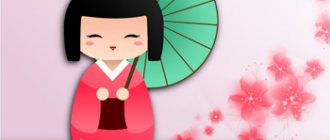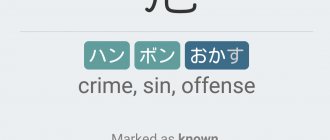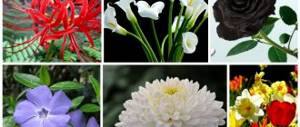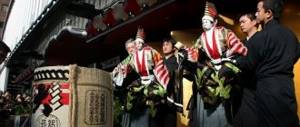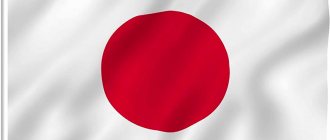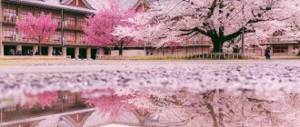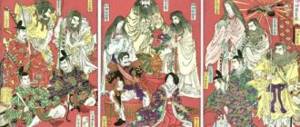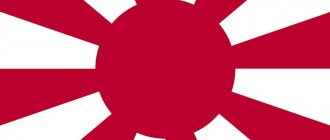Story
The history of the formation of the flag of Japan (another name is “Hinomaru”) has its roots in the distant past and begins in the 13th century. This stage is characterized by a military conflict with Mongolia. The canvas was presented to the Japanese ruler and was intended for the battle with the Mongols. The image of the sun recalled the origin of the ruler from Amaterasu, the sun goddess.
In the 16th century military leaders used the Japanese banner as a talisman. It was believed that Emperor Jimmu won the battle at the moment when the solar disk was located behind him and blinded the enemy troops with its rays. The commanders firmly believed in the symbol of the sun and always held banners behind their troops.
In the 19th century, the hinomaru began to be used by state ships of Japan. The concept of the first banner appeared in 1868; the canvas was presented in white, depicting a red circle with sixteen rays.
Towards a modern image
The flag of Imperial Japan first received the status of a state symbol in 1870. The emblem of that period is similar to the modern design, but the shape of the canvas was more elongated. The current aspect ratio is 7:10. The red circle was not exactly centered, but was shifted 1% to the left.
This was the reign of Emperor Meiji. The period is characterized by dramatic changes and reforms, when in a short period of time the country became one of the largest world powers. The development of the concept of a state standard has become a necessary measure for organizing communication with other states.
However, in 1885, the hinomaru lost its status as a state symbol. The innovations did not in any way affect the practical use of the cloth.
Four years later, the navy banner appeared. Against the background of a white canvas there was a red “luminary” with sixteen rays. However, the circle was not placed in the center, but shifted to the left.
Flag of Japan during World War II
Particular importance was attached to the national standard during the war. The canvas was raised during the military conflict with Russia and armed confrontation with Asian states (Mongolia, China). In the occupied lands, the Japanese hung a white and red banner in order to form the patriotic values of the people. They raised the banner not only on the streets, but also in educational institutions. Next to the fluttering hinomaru, children hummed the Japanese anthem.
Around the world, the rising banner was compared to fascist symbols. Just as the swastika of Nazi Germany reminded Europeans of the invasion.
The flag of a militaristic country during the Second World War is firmly entrenched in the memory of the Japanese and the world community. After the end of the war, the symbols of Japan aroused only hostility. The general rejection of the colors and emblem of the flag gave rise to many disputes, but the country prioritized issues of economic and social development. Therefore, no one addressed the issue of changing the state symbol.
Flying the national flag has been banned in Japan since 1945, as the country came under US control after losing World War II. Only the American military administration gave permission to raise the banner. The situation changed 4 years after the lifting of occupation restrictions.
In the early 90s, the question arose of returning the “luminary” to the status of a state symbol, since society demanded that the banner be raised at ceremonies.
The official status of the flag was secured in 1999. At the same time, the “Law on the State Flag” was published, which is still relevant today. The drawing has changed slightly, its size has increased. The circle was again placed in the center. The proportions of the modern version of the canvas were 2:3.
Doping manipulations
The history of doping scandals and proceedings began a long time ago. In 2016, Canadian professor Richard McLaren presented his report on corruption in Russian sports, the investigation of Russian doping fraud at the Sochi Olympics and support for doping at the state level since 2011.
During the investigation, WADA for a long time requested the transfer of data to the Moscow anti-doping laboratory. When the data was finally received, it was discovered that changes had been made to it. Later, experts proved the fact of manipulation with the database.
After this, it was useless to expect any concessions from WADA for Russia.
“We forbid you to think in Russian.” Russian synchronized swimmers were left without bears on their swimsuits
Other flags
The ground forces fly a white banner, in the center of which is a red circle with eight rays. The edges are edged with a golden hue.
The Navy is displaying a canvas depicting a red sun with sixteen rays on a white background. The circle is shifted to the left. This version is similar to the 1889 naval ensign.
The Emperor's standard is slightly different. A golden flower, a chrysanthemum, is drawn on a red background. This emblem serves as the national emblem of Japan. The flower has long symbolized happiness and longevity and was the ancestral sign of emperors.
The standard of the empress is almost identical to the canvas used by her husband. There is a cutout on the opposite side of the shaft; in appearance it resembles a “dovetail”.
Nicaragua
Nicaragua is a country located in Central America. This is the name of a small area surrounded by water that connects North and South America. This country was also able to approve its banner only after gaining independence, but from Spain.
It is noteworthy that the purple hue appeared in the heraldry of this country back in 1823, when the first flag of the independent republic was approved. The banner is a blue-white-blue canvas with the image of a triangle filled with various natural phenomena.
No sign of purple tones? Yes, they are not immediately noticeable. But try to take a closer look at the triangle in the center.
We depict a real rainbow, in which, although not all colors are visible, there is definitely purple. In fact, the triangle in the center is the coat of arms of Nicaragua, which is considered an integral element of the flag. The rainbow, as a heraldic element, represents peace and freedom.
Symbolism and meaning of flowers
The red circle against a white background represents the sun rising in the east. It gives people light and warmth.
The color combination has the following meaning:
- red – personifies solar energy and sacred fire;
- white – pristine purity, honesty.
The combination of red and white colors in the Land of the Rising Sun symbolizes happiness and fun.
Hinomaru, as a sign of the state, is closely related to the symbolism of some prefectures. Each region has its own symbol. The Tokyo sign is very similar to the flag of Japan - a white “luminary” with six rays is drawn against a purple background.
Full list
Eight large regions unite all the prefectures of Japan. The list of administrative units is as follows:
— Hokkaido is a special prefecture divided into 14 districts;
— the Kyushu region includes the prefectures: Miyazaki, Okinawa, Nagasaki, Kumamoto, Kagoshima, Saga, Oita, Fukuoka;
— Tohoku unites Fukushima, Aomori, Miyagi, Akita, Yamagata, Iwate;
— Shikoku includes the prefectures of Tokushima, Kagawa, Kochi, Ehime;
— the Kanto region consists of the prefectures of Chiba, Tochigi, Saitama, Ibaraki, Gunma, Tokyo;
— Chugoku unites Yamaguchi, Shimane, Tottori, Okayama, Hiroshima;
— the Kinki region consists of the prefectures of Wakayama, Hyogo, Mie, Nara, Kyoto, Osaka, Shiga;
- Chubu includes the territorial units of Yamanashi, Gifu, Nagano, Ishikawa, Niigata, Toyama, Fukui, Shizuoka, Aichi.
Interesting Facts
There are several interesting facts associated with the flag of Imperial Japan:
- The development of their own flag for the Japanese became a necessary measure. At that time, in Asian culture, the banner was not perceived as a national insignia. Banners were used only by feudal warriors; the family coat of arms was depicted on the canvases.
- Flag Day in the Land of the Rising Sun is celebrated on August 13. The date when the last design of the panel was approved in 1999.
- Since the day it was first raised, the national symbol has not changed.
- ⅗ of the canvas is allocated for the red circle.
- Taking into account the regulations of 2008, synthetic fabrics - nylon and acrylic - must be used for the manufacture of canvases.
- Damaged paintings should be burned in a private setting.
- The shade of the circle often changes. Initially it was dark red, but after the approval of the latest concept it became scarlet. Sometimes it is replaced with rich red.
- “Hachimaki” - on the heads of the Japanese you can often see a bandage identical to the national flag. The local population considers it a personal talisman. The Japanese believe that the bandage helps prevent misfortunes and gives strength to pregnant women, athletes before competitions, and students.
- During World War II, a special Japanese tradition arose - the use of the Japanese standard as a commemorative postcard. Postcards with wishes were considered a protective amulet and were sent to the warring Japanese. A prerequisite is that the inscriptions were located outside the “luminary”.
- China and Korea are countries where hanging a Japanese banner is considered an insult to the nation, since at one time they experienced Japanese aggression.
In the Land of the Rising Sun, hinomaru still remains the main state symbol. The canvas not only recalls the spirituality and geographical location of Japan, but also allowed the state to strengthen its position among other world powers. The rising sun has long been respected by the Japanese, who attach special importance to it and believe in the miraculous abilities of the banner.
Pictograms of the Tokyo 2020 Olympics
500 days before the start of the championships, the Olympic Games Committee presented a series of 50 pictograms for 33 sports. For the first time, animated pictograms were created. The author of this concept wanted to emphasize the grace, dynamism and strength of athletes.
The images are made in the colors of the emblem: white and indigo. The style of the emblems is a reference to the 1964 Olympic pictograms.
It is noteworthy that some sports have multiple icons because they have different disciplines.
Prefecture coins
Since 2008, the mint began producing “Japanese Prefecture” coins, which are also designed to highlight the uniqueness of each region. While not all prefectures have acquired their own coin, this program lasted for several years. But the issued banknotes impress with their beauty and thoughtfulness: the most important symbols of the territory are chosen for the image. For example, a coin from Shiga Prefecture features a drawing of the outline of Lake Biwa, the largest in Japan. Also on the reverse you can see an image of the little grebe bird, which lives on the lake. The coins of Okinawa, Miyazaki and Kanagawa prefectures depict warriors in typical attire for the region. The main architectural landmarks of the territory were chosen as the background for the human figures.
Dolls in Japan
Dolls in Japan are part of the national culture. There are dolls that are only taken out on holidays. And there are those that can be played every day. There are dolls for contemplation, as well as those made from scrap materials. Japan even holds doll exhibitions and festivals where they sell interesting doll souvenirs to tourists.
The history of the Japanese doll is directly related to mysticism and witchcraft. In ancient Japan, dolls were created by village sorcerers to heal or harm a person. Information has been preserved about rituals where the patient was asked to blow on a paper or bamboo doll, or roll it over the body, and then drown this thing in the river, or burn it. It was believed that in this way the disease would be transferred from a person to a doll, and would perish in the waters of the river, or burn in a fire.
In the Japanese dictionary there is a word "ninge" which means doll. Japanese dolls are divided into the following categories:
- Festive dolls or “hina-ninge”. The Hinamatsuri holiday is celebrated in honor of the imperial family. And the main characters on it are dolls. On this day, almost every family takes out carefully packed dolls from a hidden place in the house, representing all members of the imperial family. And these expensive toys are installed on a special stand or steps according to seniority. First, the emperor doll is placed, then his wife, children, advisers and all other courtiers in accordance with the regulations. On such a holiday, they go to visit each other and contemplate beautifully displayed dolls;
- Samurai dolls or "gogatsu-ninge". These toys depict samurai or other valiant warriors. The set may also include figurines of animals and historical characters. These dolls are used during the Tango no Sekku festival;
- "Chrysanthemum" dolls or "kuku-ninge". These products are made from bamboo and live chrysanthemums planted in a frame with roots. They are used as exhibition pieces for exhibitions during the flowering period of chrysanthemums.
In addition to the listed dolls, clay and mechanical toys, wooden tumblers for small children, and talisman dolls that bring good luck are common in Japan.
